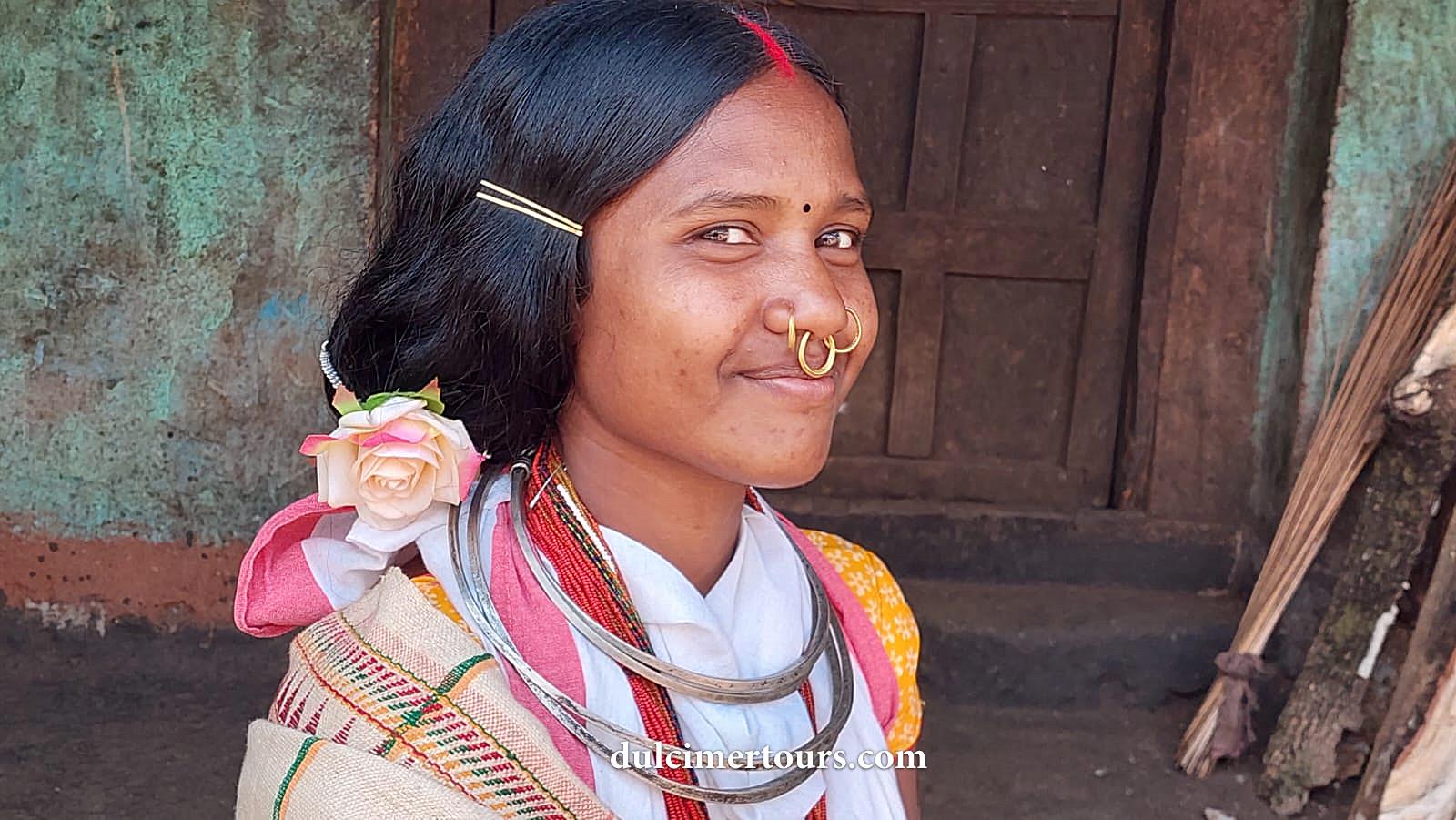Tribes of Orissa
Orissa is wonderful land of tribal culture, among the 62 different tribal communities live in Orissa, we try to description here some the most colorful groups and their festival, who maintain and preserve their culture and tradition still today.
Explore and experience the real charm of colorful culture and tradition of tribal life with our tours in Odisha ( Orissa). Comes in a special interest tour package at an affordable price.
For instant unique itinerary based on the below given colorful tribal communities please feel free to Contact Us.
Duration of Tour: 14 Night/ 15 Days
DONGRIA KANDHA:
In the remote mountainous wilderness of the Eastern Ghats region of South Orissa lives a fascinating Kuvi-speaking tribe called, the Dongria Kandha. They inhabit the lofty Niyamgiri hill ranges in the district of Rayagada. They stand apart from 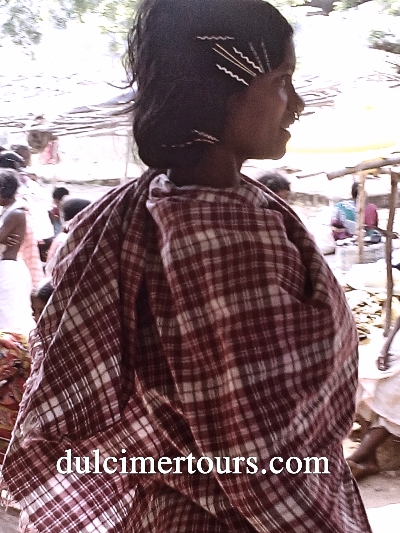 others for their famous Meria festival, expertise in horticulture and colourful dress, adornments and life style. For being the denizens of hills, forests and highlands (dongar), their neighbours name them Dongria. Dongria men and women are quite fashionable in their personal adornments, that makes them attractive and distinguish them from others. Dongria men put on a long and narrow piece of loin cloth and women use two pieces of cloth, each 3-4 ft. In length. Both men and women grow long hair. A wooden comb (kokuya) is fixed at the hair knot of men and women which adorns the hair-lock and keeps the hair tight. A tiny knife (pipli) with colourful thread balls at its metal handle, adorns the hair lock of women. Men and women put on aluminum neck rings, beads & coin necklaces (kekodika), finger rings. In addition to that women wear bangles, anklets, toe rings. Both men and women wear earrings and nose-rings.
others for their famous Meria festival, expertise in horticulture and colourful dress, adornments and life style. For being the denizens of hills, forests and highlands (dongar), their neighbours name them Dongria. Dongria men and women are quite fashionable in their personal adornments, that makes them attractive and distinguish them from others. Dongria men put on a long and narrow piece of loin cloth and women use two pieces of cloth, each 3-4 ft. In length. Both men and women grow long hair. A wooden comb (kokuya) is fixed at the hair knot of men and women which adorns the hair-lock and keeps the hair tight. A tiny knife (pipli) with colourful thread balls at its metal handle, adorns the hair lock of women. Men and women put on aluminum neck rings, beads & coin necklaces (kekodika), finger rings. In addition to that women wear bangles, anklets, toe rings. Both men and women wear earrings and nose-rings.
BONDA:
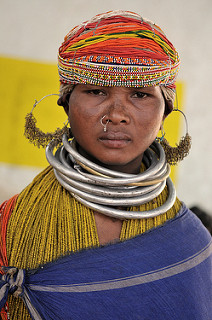 In the wild and remote mountainous country located towards the south-western tip of the Malkanigiri highlands lives a unique tribal community called- “Bonda”. The tribesmen identify themselves as “Remo” (man). Bonda speak a language of their own that belongs to the Austro- Asiatic (South Mundari) language group. Bonda men are brave and bold. They derive their identity from their arms, such as bow, arrows, long knife which they always carry and sago palm-wine which is their most favorite drink. The Bonda women with their clean-shaven head decorated with head bands of Palmyra strips and plaited fillets of caryota fibber. Mass of colorured beads and shell strings, brass neck rings and necklaces hanging down even below the navel and the brass bangles covering the whole of the lower arms are the typical ornamentation of the Bonda Women. A short and narrow strip of striped loin-cloth woven at home by a double-bar tensioned loom covering only the private parts comprises the woman’s wear.
In the wild and remote mountainous country located towards the south-western tip of the Malkanigiri highlands lives a unique tribal community called- “Bonda”. The tribesmen identify themselves as “Remo” (man). Bonda speak a language of their own that belongs to the Austro- Asiatic (South Mundari) language group. Bonda men are brave and bold. They derive their identity from their arms, such as bow, arrows, long knife which they always carry and sago palm-wine which is their most favorite drink. The Bonda women with their clean-shaven head decorated with head bands of Palmyra strips and plaited fillets of caryota fibber. Mass of colorured beads and shell strings, brass neck rings and necklaces hanging down even below the navel and the brass bangles covering the whole of the lower arms are the typical ornamentation of the Bonda Women. A short and narrow strip of striped loin-cloth woven at home by a double-bar tensioned loom covering only the private parts comprises the woman’s wear.
KUTIA KANDHA:
The Kutia Kandha is a section of the Kandha tribe found in Kandhmal and Kalahandi dist. (south central part) of 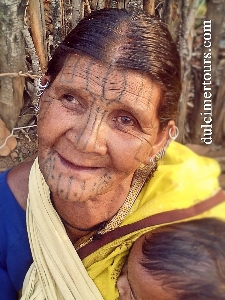 Orissa. The tribesmen are known for their buffalo sacrifice ritual locally known as “Kedu” to worship their Earth Goddess- “Darni Penu”. They belong to the Proto-Australoid racial stock and shspeak a dialect their own called “Kui”, which belong to Dravidian language family. They worship large number of deities and spirits; the chief among them is Darni Penu, the Earth Goddess worship by the village headman called Majhi & the village priest is called Jani.
Orissa. The tribesmen are known for their buffalo sacrifice ritual locally known as “Kedu” to worship their Earth Goddess- “Darni Penu”. They belong to the Proto-Australoid racial stock and shspeak a dialect their own called “Kui”, which belong to Dravidian language family. They worship large number of deities and spirits; the chief among them is Darni Penu, the Earth Goddess worship by the village headman called Majhi & the village priest is called Jani.
LANJIA SAORA:
The saoras are one of the most ancient tribes of India. Have a racial affinity with the Proto- Australoid stock, their dialect called Sora, comes under the Austro-Asiatic family of Munda  group of languages. Lanjia Saora constitutes one of the primitive sections of the Saora tribe. They are so called by their neighbours strip of male loin cloth is worn in such a fashion that both the red embroidered ends hang down in front and back like a tail (Lanja). Their women greatly enlarge their enlarge their ear lobes to wear rounded wooden pegs and have a characteristic tattoo mark down the middle of the forehead. Install the village deities represented by wooden posts at the entrance of the village. Have male and female shamans to serve their magico-religious needs. Famous for their attractive wall paintings,” IDITIAL”. Observe Guar, the secondary burial ritual to commemorate the dead by sacrificing buffaloes and by erecting menhirs.
group of languages. Lanjia Saora constitutes one of the primitive sections of the Saora tribe. They are so called by their neighbours strip of male loin cloth is worn in such a fashion that both the red embroidered ends hang down in front and back like a tail (Lanja). Their women greatly enlarge their enlarge their ear lobes to wear rounded wooden pegs and have a characteristic tattoo mark down the middle of the forehead. Install the village deities represented by wooden posts at the entrance of the village. Have male and female shamans to serve their magico-religious needs. Famous for their attractive wall paintings,” IDITIAL”. Observe Guar, the secondary burial ritual to commemorate the dead by sacrificing buffaloes and by erecting menhirs.
GADABA:
Culture of the Gadaba, one of the prominent tribal communities of Orissa. 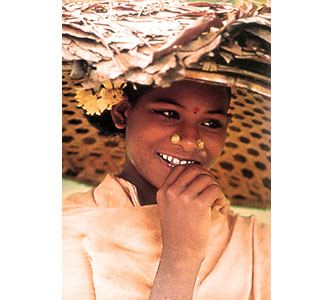 The name; Gadaba has been derived from the word “Gada”, name of a brook in the Godavari valley. The tribe has Proto-Australoid origin. The Gadaba speak Mundari language, called Gutob belonging to Austro-Asiatic language family. The Gadaba men use a piece of cloth, called lenguthi with a flap, which hangs down in front. Women wear two pieces of cloths, each measuring about 5ft. By 2 ft. Called Keranga. The Gadaba girls/ women decorate their bodies with ornaments such as peculiar type of earrings, which are made out of brass or aluminium which hangs down from a hole in the ear that reaches the shoulder. Besides, they use ornaments, like rings (mudi) bangles made of brass. Their hair is neatly combed and fixed at the back by hairpins.
The name; Gadaba has been derived from the word “Gada”, name of a brook in the Godavari valley. The tribe has Proto-Australoid origin. The Gadaba speak Mundari language, called Gutob belonging to Austro-Asiatic language family. The Gadaba men use a piece of cloth, called lenguthi with a flap, which hangs down in front. Women wear two pieces of cloths, each measuring about 5ft. By 2 ft. Called Keranga. The Gadaba girls/ women decorate their bodies with ornaments such as peculiar type of earrings, which are made out of brass or aluminium which hangs down from a hole in the ear that reaches the shoulder. Besides, they use ornaments, like rings (mudi) bangles made of brass. Their hair is neatly combed and fixed at the back by hairpins.

